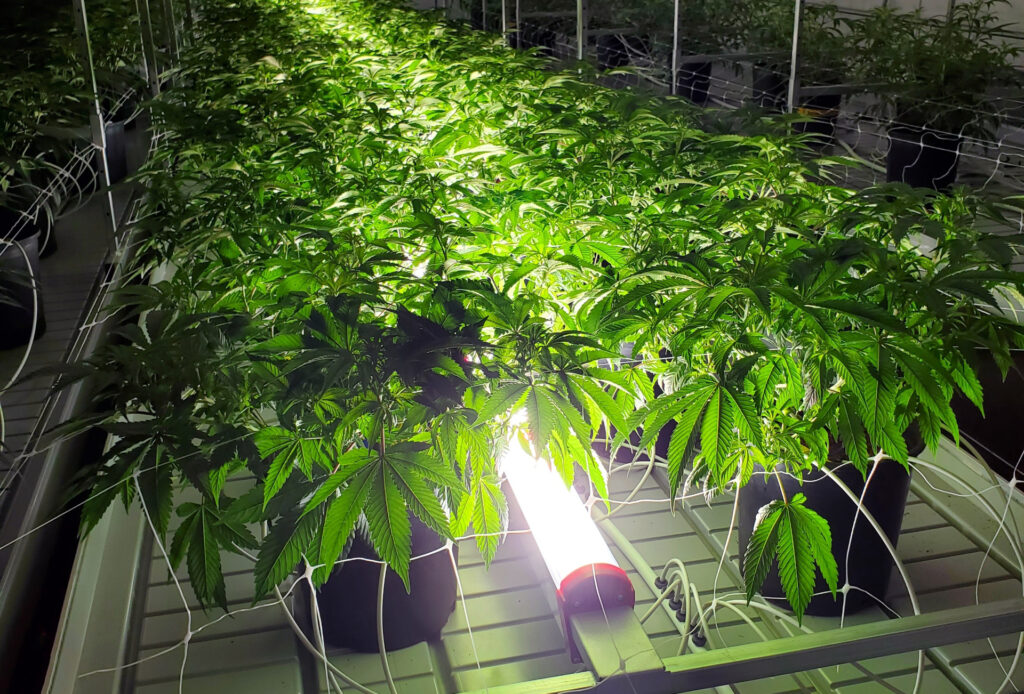
March 12, 2025
Introduction
For decades, scientists viewed genes as static “blueprints for life,” determining all traits with little room for change. Emerging research now shows that environmental stimuli can fundamentally alter gene expression— and that these alterations can be inherited by offspring. Epigenetics (literally translates to Above the Genes), the study of heritable traits, or a stable change of cell function, that happen without changes to the DNA sequence, explains how organisms adapt to stress without modifying their underlying DNA [1]. Unlike permanent mutations, epigenetic modifications are reversible yet persist beyond the initial trigger. Factors like temperature, drought, light spectrum, and even microgravity can induce heritable changes in gene expression, affecting metabolism, development, and stress responses.
Epigenetics is rapidly gaining attention as an important regulator of plant growth and a promising tool for advanced breeding. Cannabis has become a key model for investigating how environment-driven epigenetic changes govern secondary metabolism and stress resilience. This review explores recent progress in epigenetics, emphasizing its potential benefits for cultivation strategies, stress tolerance, and breeding innovations.
Mechanisms of Epigenetic Regulation
Environmental stimuli can affect gene activity in both transient and heritable ways. Many transient responses—such as light-induced changes in metabolism or heat-stress signaling—revert once the stimulus ends and are thus non-epigenetic. In contrast, true epigenetic modifications persist across cell divisions or generations. These epigenetic modifications generally fall into three main categories (Figure 1)
- DNA Methylation – Methyl groups bind to DNA, typically reducing transcription by blocking transcription factor access. Certain stressors (e.g., drought or temperature fluctuations) can trigger persistent methylation changes – priming plants for future challenges [2].
- Histone Modifications – Chemical tags (such as acetyl or methyl groups) on histone proteins alter how tightly DNA is packaged in chromosomes. Acetylation typically promotes transcription, while methylation can either activate or repress genes. Histone modifications may play an important role in regulating THC and CBD production [3].
- Small RNA-Mediated Regulation – Small RNAs (siRNAs, miRNAs) guide degradation or repression of specific messenger RNAs (mRNAs). The effects are fine-tuned gene expression during stress adaptation, pathogen defense, and genetic stability [4].
Together, these mechanisms embed environmental “memory” into plant genomes, shaping development, metabolic activity, and, in some cases, heritable adaptations.
Stress & Epigenetics
Epigenetic modifications help plants integrate past environmental experiences into current gene expression. Stress-induced shifts in DNA methylation, histone modifications, or small RNA activity can enhance resilience and may persist across generations (Figure 2).
For example, drought and temperature stress can alter DNA methylation in Arabidopsis, wheat, and rice, improving water-use efficiency and heat tolerance [5].
Recent research on cannabis suggests an important role of epigenetics in regulating secondary metabolism. In cell suspension cultures, UV exposure induced hypermethylation that upregulated genes encoding enzymes in the cannabinoid and terpene biosynthetic pathway, leading to increased CBD and THC production [6]. While this demonstrates the epigenetic regulation of secondary metabolism in undifferentiated cells, the impact on whole-plant epigenetics remains to be fully explored. See our recent review – Ultraviolet Radiation, Cannabinoids, and an Unequivocally Equivocal Contribution – for a summary of findings on whole-plant responses to UV.
Under simulated microgravity, cannabis callus cells upregulated genes involved in CBG, THC, and CBD biosynthesis. Despite an increase in THCA synthase gene expression, THC concentration decreased, underscoring the complex relationship between gene regulation and measurable traits [7].
Epigenetics and the Future of Cannabis Cultivation
The cannabis industry aims for consistent yields, stable chemical profiles, and robust stress tolerance—goals epigenetics could help achieve. Variability in environmental conditions often cause variability in cannabinoid and terpene profiles, and epigenetic factors may contribute to some of these inconsistencies. Selecting cultivars with more stable epigenetic marks may improve yield predictability and chemical uniformity.
Recent findings in epigenetic breeding show that heritable epigenetic variation can improve crop resilience, yield stability, and metabolic traits, adding a new dimension to crop improvement beyond conventional genetics [8]. Epigenetic modifications can be induced, then selected for, enabling breeders to shape plant performance without altering DNA sequences (Figure 3) [9]. In cannabis, this could help stabilize chemotypes and reduce variability across different cultivation environments.
Epigenetic priming—deliberately exposing plants to mild stress—has improved resilience and secondary metabolism in other species, including corn and soybean [10]. Applied to cannabis, epigenetic priming may improve stress tolerance and increase secondary metabolism.
Conversely, resetting epigenetic marks may also be important. Tissue culture, widely used to eradicate viruses and restore vigor in clonal propagation, often erases stress induced epigenetic imprints, thereby stabilizing genetic and epigenetic states across clones.
Ongoing advances in “reverse” epigenetics offer more precise ways to manipulate epigenetic modifications, opening new avenues for investigating stress tolerance and secondary metabolite production [9] [10]. As methods to reset or control these states improve, breeders will likely integrate genetic selection with epigenetic profiling to identify plants that maintain stable gene expression in diverse settings. Tools like genome-wide methylation mapping and chromatin analysis are becoming increasingly accessible, paving the way for refined breeding strategies and more robust cannabis cultivars [11]
Conclusion
Epigenetics explains how environmental conditions can drive lasting shifts in gene expression and plant growth and development. Cannabis secondary metabolism—especially in trichomes—may be regulated, at least in part, by epigenetic mechanisms. As research expands, epigenetically informed cultivation practices can enhance yield consistency, chemical quality, and overall stress tolerance.
The growing understanding of epigenetics, plant memory, and stress priming suggests future breeding efforts and cultivation methods will harness how cannabis ‘remembers’ and adapts to the environment. By leveraging these processes, the industry can move toward more consistent, sustainable, and resilient cannabis production.
References
1. Penner-Goeke, S. & Binder, E. B. Linking environmental factors and gene regulation. eLife 13, e96710 (2024).
2. Epigenetic Regulation in Plant Responses to the Environment. https://cshperspectives.cshlp.org/content/6/9/a019471.
3. Conneely, L. J., Hurgobin, B., Ng, S., Tamiru-Oli, M. & Lewsey, M. G. Characterization of the Cannabis sativa glandular trichome epigenome. BMC Plant Biology 24, (2024).
4. Castel, S. E. & Martienssen, R. A. RNA interference in the nucleus: roles for small RNAs in transcription, epigenetics and beyond. Nat Rev Genet 14, 100–112 (2013).
5. Abdulraheem, M. I. et al. Mechanisms of Plant Epigenetic Regulation in Response to Plant Stress: Recent Discoveries and Implications. Plants (Basel) 13, 163 (2024).
6. Abedini, M., Iranbakhsh, A., Saadatmand, S., Ebadi, M. & Ardebili, Z. O. Low UV radiation influenced DNA methylation, gene regulation, cell proliferation, viability, and biochemical differentiation in the cell suspension cultures of Cannabis indica. Journal of Photochemistry and Photobiology B: Biology 254, 112902 (2024)
7. Darigh, F., Iranbakhsh, A., Oraghi Ardebili, Z., Ebadi, M. & Hassanpour, H. Simulated microgravity contributed to modification of callogenesis performance and secondary metabolite production in Cannabis Indica. Plant Physiology and Biochemistry 186, 157–168 (2022)
8. Tirnaz, S. & Batley, J. Epigenetics: Potentials and Challenges in Crop Breeding. Molecular Plant 12, 1309–1311 (2019).
9. Villagómez-Aranda, A. L. et al. Activating stress memory: eustressors as potential tools for plant breeding. Plant Cell Rep 41, 1481–1498 (2022)
10. Harris, C. J., Amtmann, A. & Ton, J. Epigenetic processes in plant stress priming: Open questions and new approaches. Current Opinion in Plant Biology 75, 102432 (2023).
11. Liu, J. & Zhong, X. Population epigenetics: DNA methylation in the plant omics era. Plant Physiology 194, 2039–2048 (2024).




